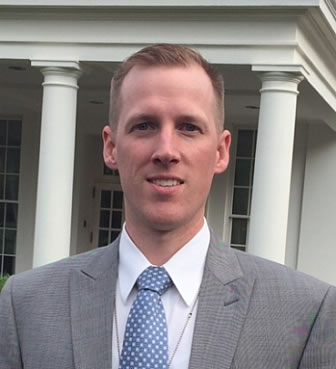BetaGov Interviews
Interview with Jeremiah Johnson

Date: June 11, 2019
This month we feature an interview with Jeremiah Johnson, a Sergeant with the Darien (Connecticut) Police Department and an NIJ LEADS Scholar. Jeremiah was the first Pracademic to test cruise/blue/code lights on patrol vehicles to deter crime. Since the first cruise-lights trial conducted with BetaGov, several others have been launched in the United States and Canada. Jeremiah's experience and willingness to offer peer-to-peer consultation was instrumental in developing those trials. We recently talked with Jeremiah about his experience and the opportunities for iterative learning with each new cruise-lights trial.
How did you come up with the idea to use cruise/blue lights to try to deter crime?
I was in Washington, DC, in 2015 for the ASC conference and saw police vehicles posted at busy intersections with blue lights on. These were highly visible from down the street. I learned that [MPDC] Chief Ramsey was using this approach to make police more visible. In my agency, we had moved to a new LED light bar on our vehicles, so we have the capacity of using static lights. Our officers use these in bad weather conditions and at crowded events to convey police presence, rather than an emergency. We also use these at bar closing time on the midnight shift to help prevent problems.
Our community had a problem with auto-theft crews coming down I-95 (the large highway running past our area), getting off on one of the three exits into town during specific early-morning hours. I had officers on midnight shift park on the exit ramps, visible from the highway, with their lights on to deter the crews from coming into town. We didn't measure this at first, but anecdotally it seemed that these crime crews were hitting other towns. In 2016 we got a new chief who was open to out-of-the-box ideas, and he was receptive to my suggestion about testing cruise lights to deter crime.
Did you have any challenges in developing and implementing your trial?
I initially planned on conducting a trial in my jurisdiction and a jurisdiction in another county that was interested, but two adjacent jurisdictions learned about the trial and wanted to participate. We ended up with a four-site study. There were tradeoffs with this plan in that, although we had a larger sample size, we were limited in the scope of the data-collection instrument. For example, we initially wanted to capture vehicle mileage as a performance measure, but it wasn't a metric that was currently being captured and there was little enthusiasm for making officers track their mileage.
As you know, several other cruiser-lights trials have been launched after yours. Were you able to provide some guidance to other Pracademics with their cruiser-lights trials?
I am glad to see that the idea is appealing to others. No one, not even Chief Ramsey, had tested the concept of police visibility in this way. Some law-enforcement Pracademics have reached out to me and we were able to discuss my trial and how the trial might be revised based on my experience. For example, one point I made is the need to obtain support for the trial at all levels of the organization. Specifically, a trial won't be feasible if mid-level and line leadership is not on board. You should also get the union involved—you don't want to create barriers to getting the trial launched and it is better to address any concerns up front. Similarly, you should always address officer safety. Obviously, you won't suggest a trial that puts officers at risk, but you should consider how the trial might actually increase officer safety. Address officer safety concerns in the research proposal and when providing guidelines to officers for experimental and control conditions. You also need to build in measures to assess fidelity to ensure that the trial was conducted as planned. If you don't, you may end up with a trial that didn't do what it was intended to do. For example, a site might include an objective measure of cruiser-light fidelity such as viewing businesses' external video surveillance to see if cruiser lights were on or off on randomly selected days.
How do you think that replication and iterative learning advance the field?
Iterative learning is a great model because it allows one to build on what happened before to move knowledge further afield. I tested an idea but encountered some limitations. To use a sports analogy: I called an audible, a different play than what is planned, based upon what I saw on the field. I feel like I didn't make it downfield very far. What is great about iterative learning is that another Pracademic can take a lateral or even pick up my fumble and run the ball closer to the endzone.
The NIJ LEADS Scholars program also provides a great platform to highlight this research and offers an infrastructure for iterative learning. I was able to present on this trial at several conferences and meetings, and also shared BetaGov's one-page snapshot on social media, which may have helped to encourage others to try something similar.
What advice can you give to others wanting to test an idea?
Those in law enforcement are bold and courageous in their day-to-day jobs—they are willing to risk their own lives for their community. I'd like to encourage them to be just as brave within their own organizations in innovating and testing ideas to improve our work. That is, don't be afraid to come up with out-of-the box ideas and propose doing something unconventional to move the profession forward.